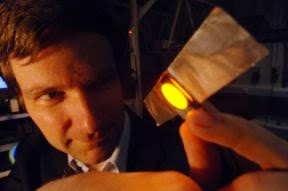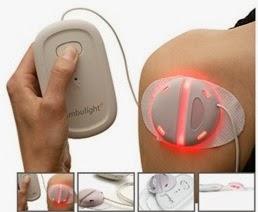“Sticking plaster” treatment for skin cancer and acne
 A wearable light source that can treat many skin cancers and acne has been invented by Professor Ifor Samuel (School of Physics and Astronomy) working with Professor James Ferguson (Ninewells Hospital, Dundee) in light-emitting-polymers. Using support from Scottish Enterprise, they showed organic light-emitting diodes (OLEDs) could be used to make a light-emitting “sticking plaster” that provides a new light source for medicine. The light-based treatment is gentler than surgery and so leads to a better cosmetic outcome. It is an improvement over conventional photodynamic therapy (PDT), which is only available in a limited number of hospitals because of the specialised equipment involved, because the patient can move around during treatment, pain is reduced, and a hospital visit can be avoided.
A wearable light source that can treat many skin cancers and acne has been invented by Professor Ifor Samuel (School of Physics and Astronomy) working with Professor James Ferguson (Ninewells Hospital, Dundee) in light-emitting-polymers. Using support from Scottish Enterprise, they showed organic light-emitting diodes (OLEDs) could be used to make a light-emitting “sticking plaster” that provides a new light source for medicine. The light-based treatment is gentler than surgery and so leads to a better cosmetic outcome. It is an improvement over conventional photodynamic therapy (PDT), which is only available in a limited number of hospitals because of the specialised equipment involved, because the patient can move around during treatment, pain is reduced, and a hospital visit can be avoided.
 Ambicare Health Ltd developed the prototype ambulatory devices into a form suitable for regulatory approval and manufacture. This resulted in two products, “Ambulight”, a portable, wearable light source with battery pack, used for treating non-melanoma skin cancers and dysplasia, and “Lustre” for the treatment of acne. The more effective, simplified treatment with Ambulight has meant an increase in the number of patients treated per clinic, a success rate of 84% of lesions being clear after one year, and patients having a comfortable, portable, home-based treatment. The advantage of Lustre is that it enables acne to be treated at home, using blue light treatment rather than drugs or chemicals. Both systems are in use in the UK and the Netherlands.
Ambicare Health Ltd developed the prototype ambulatory devices into a form suitable for regulatory approval and manufacture. This resulted in two products, “Ambulight”, a portable, wearable light source with battery pack, used for treating non-melanoma skin cancers and dysplasia, and “Lustre” for the treatment of acne. The more effective, simplified treatment with Ambulight has meant an increase in the number of patients treated per clinic, a success rate of 84% of lesions being clear after one year, and patients having a comfortable, portable, home-based treatment. The advantage of Lustre is that it enables acne to be treated at home, using blue light treatment rather than drugs or chemicals. Both systems are in use in the UK and the Netherlands.